The story of One Family who dominated fuedal Europe, and how its epic downfall birthed the modern world
In 1020s, a minor German nobleman by the name of Rodblat was made a Count, and decided to build himself a castle befitting the fancy new title. He chose the mountain country of Swabia, now in Switzerland. As his stone legacy slowly came into being, he wondered what he would call his new castle. The apocryphal story goes that at this moment a hawk decided to perch on one of the turrets of the castle. So it was that Count Rodblat named his castle “Hawks castle”, or, to translate from the German, Hapsburg. Whatever the truth of the story, his descendants, who would henceforth style themselves counts of Hapsburg, and eventually just Hapsburg, would go onto become one of the most powerful aristocrat families in Europe, irrevocably intertwined with the history of the continent’s aristocracy. While the story of the Hapsburgs is the story of traditional, feudal Europe, their spectacular demise in the end of the nineteenth and beginning of the twentieth centuries amidst the great revolutions of the time formed the backdrop to the birth of the modern world.
Travelling to Vienna in the unseasonably warm spring in the year of our lord 2024, I visited the Hapsburgs summer and winter palaces, the Hofburg and the Schonnbrun. Their relentless opulence brings home the fact that for 650 years these people were the first family of Europe. Whilst, like other aristocrat families, they did engage in the odd territorial conquest, the Hapsburg strength was in their tactical and strategic marriages into almost all of Europes great royal houses.

By the sixteenth century, when a Hapsburg, Charles V, through these marital machinations, became King of Spain by inheriting for the first time the twin thrones of Aragon and Castille, it seemed like there was a Hapsburg on every throne of Europe. Of course, by this time the Hapsburgs had long since abandoned their ancestral homelands in the Swiss Mountains for Vienna, their permanent base since the 1200s. Until the nineteenth century, the words “Austria” and “Hapsburg” were used interchangeably.
However this particular son of Austria Charles V not only inherited the crowns of Spain but also the crown of the Holy Roman Empire, and as such also ruled over much of modern Germany and Northern Italy. His vast network of marriage alliances didnt just land him those two massive prizes either – they also made him the King of Naples, King of Sicily and of Sardinia, of the Netherlands, Luxembourg, of French Burgundy, of Bohemia (in modern day Czechia) and last but certainly not least, the mighty kingdom of Hungary (which comprises what is now not just Hungary, but Slovakia, Slovenia and Croatia). And of course through the crown of Spain, he was also inheritor of Spains vast colonies in the New World. It was under Charles’ Hapsburg banner that Hernan Cortez and the conquistadores brought fire and plague to the cities of the Aztecs and the Incas. The term “the empire on which the sun never sets”, which famously came to be applied to the British empire, was in fact coined for Charles V, and his unprecedented world-spanning dominions. Not a bad job by the Hapsburg match-makers, about whom the famous hexameter said Bella gerant alii, tu felix Austria nube (“Let others wage wars: you, fortunate Austria, marry”).

The strategy of course did come across some natural restrictions. Intermarrying into every family in Europe and then ensuring the dynastic rewards were kept in the family meant a significant degree of inbreeding, resulting in many later Hapsburgs being born with a whole host of developmental problems, mental health issues and physical deformities, the most infamous of which is the “Hapsburg jaw”. Inbreeding would actually lead to the Hapsburgs losing Spain about two hundred years after Charles V – as the last Hapsburg king of Spain was so inbred he was infertile and died without an heir (genetic testing of the remains of this last King shows an inbreeding co-efficient on par with someone whose parents are siblings). However this was far from the end of this dynasty, who still retained most of the impressive dominions listed above- this would not be threatened until the end of the eighteenth century and the beginning of the Age of Revolution.
The Age of Revolution, 1789- 1848
Given that the Hapsburg fortunes were so tied into their dynastic claims, they had a huge interest in safeguarding the old feudal order of Europe, and became the centre of conservative opposition to the new currents rumbling under the surface of the eighteenth century and the age of Enlightenment, with it’s dirty new notions of “democracy” and “popular government”. As Holy Roman Emperors they were also appointed by the Pope to be the guardians of the Catholic church – something which had made them in an earlier age the key opponents of the Protestant reformation, which had exploded right under their noses in their Germanic heartlands.
Despite all this, when news first reached the Schonbrunn palace in 1789 from France that a Parisian mob had surrounded and burned down the Bastille, the Hapsburg emperor Joseph II was not that worried. He had no reason to believe that this would be anything more than the the average peasants revolt which every king had to contend with at some point or the other, and himself having a decidedly un-Hapsburg pro-Enlightenment streak, was not unsympathetic to some of the demands of the mob, such as abolition of forced serfdom, and some limited freedom of speech and religion, though of course the stuff about elections and denunciations of the Catholic church was a bit too far. Even the increasingly frantic letters of his little sister, the French Queen Marie Antoinette (of course, a Hapsburg!) about what was starting to be called a “Revolution” did not move him to intervene, and he may even have secretly hoped to profit from the troubles of his long term rival, the King of France. However, when in 1793, one of the most ancient continuous monarchies in the world came to a dramatic end with the executions of Louis XVI and Marie Antoinette at the guillotine before cheering French mobs, the Hapsburg emperors realised that this “Revolution” heralded something altogether new and more insidious. This was an attack on the concept of monarchy itself, something with potential to extend beyond the borders of France.
“Soon all the Kings of this Earth shall be driven out into the desert, like the wild beasts whom they resemble, and Nature shall resume her rights” – St. Just, French revolutionary
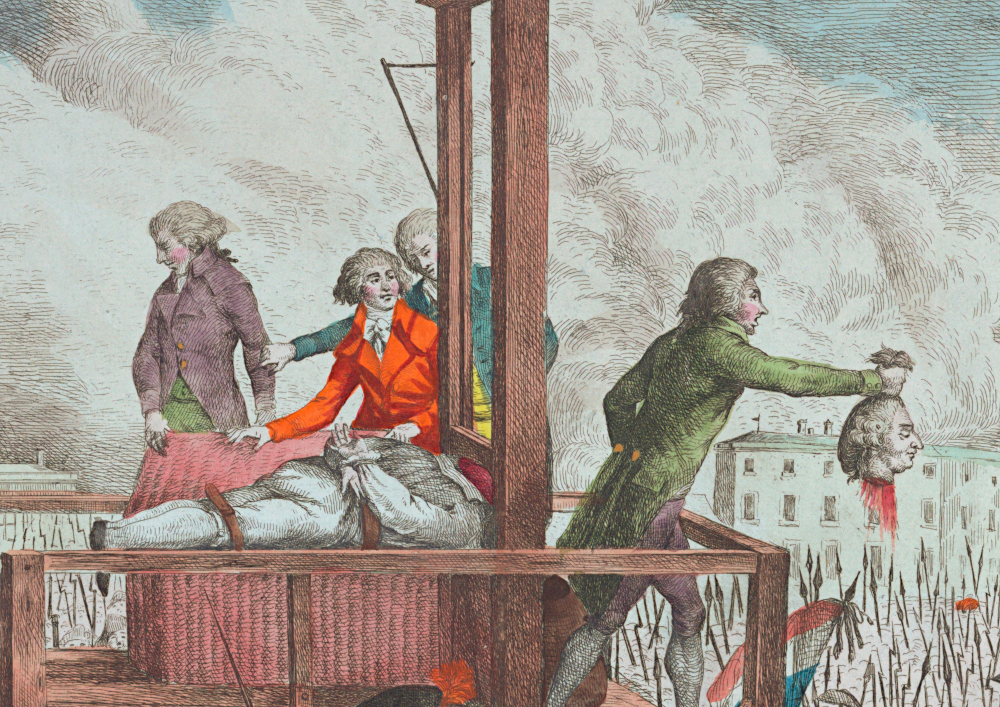
Leopold II Hapsburg, who succeeded Joseph II, was of a more traditionally Hapsburg conservative disposition. He did not have to look far to find a reason to stamp out this “French revolution”, for the revolutionary authorities in Paris themselves declared war on Austria, in what they memorably called, “a war of peoples against kings”. Joined by the Crowns of England and Spain and the Dutch Republic, Austria began a multi-pronged invasion of France. Despite an early, “against the odds” victory by the French revolutionaries at Valmy, the French proved no match for the experienced war hardened troops of the Hapsburg. The revolutionaries for their part had assumed that, inspired by their example, all the “oppressed and enslaved” peoples of Europe, including those in the vast Hapsburg dominions, would rise up against their Kings to assist them in their “crusade of liberty” . This did not happen, and a war that the revolutionaries had assured their supporters would conclude in a matter of months dragged on year after miserable year. Perhaps they would have done well to heed the sole dissenter against the war of liberty, Maximillen Robespierre, who cautioned that, oppressed as they may be, people do not tend to welcome “armed missionaries”, especially when they are foreigners. The revolutionary authorities in France descended into bitter infighting over the catastrophic state of the war, which then became full blown civil war. Austria and Britain were confident of total victory within months – the French, it seemed, were set about destroying themselves.
Then out of nowhere came Napoleon Bonaparte, who turned everything on its head. In a year Napoleon seized all of Austrias lands in Italy, establishing secular republics in his wake, and as a further snub to Catholicim’s anointed Hapsburg protectors, imprisoned the Pope and stripped him of his titles. Leopold II soon had to contend with the fact that the godless Napoleon’s cannons could be heard in the suburbs of Vienna itself. Leopold II, Holy Roman Emperor and heir to one of the most powerful families in Europe,, had to send delegates to bargain a humiliating peace with Bonaparte. One can only imagine the pristine, blue blooded delegates reactions at being dictated terms by a peasant Corsican and his largely commoner troops, with their coarse languae and threadbare coats. This upside down world would not be a temporary thing either – the Napoleonic wars would last for twenty three years.
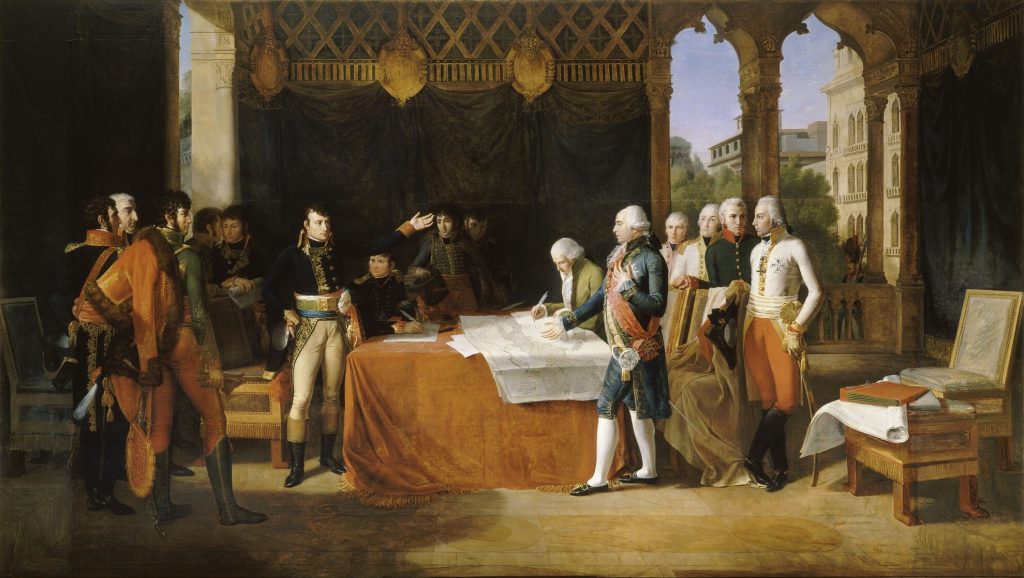
Springtime of the Peoples
However, we know that even Napoleon was eventually defeated. The period after Waterloo in 1815 to 1848 was a golden age of conservatism; with the Italian states created by Naopleon disbanded and returned to their traditional rulers, monarchy restored even in France. Humanity’s brief experiment with “democracy” had ended – it was all very good as an ideal, but kings anointed by God had existed from the beginning of humanity in every known culture and was the “natural” state of humankind. The French revolution had shown that “democracy” led either to the violent anarchy and guillotine happy mobs like in 1793, or to to warmongering dictatorship like that of Napoleon. Tradition had emerged triumphant in the war of ideologies and the end of history had been reached. The Hapsburgs were in a new golden age, having actually expanded their territories in Italy after Napoleon’s defeat. This period of over thirty years is actually known as the age of Metternich, after an Austrian diplomat called Klemens Metternich, a nineteenth century Kissinger type figure, who presided over all the great conferences of Western Europe and created a system whereby all the monarchies of Europe would collaborate to ensure the discredited, dangerous ideas of popular government would never ever see the light of day. Censorship and secret police were the orders of the day – rather than introspect, the monarchs doubled down on absolutism, and none more so than the Hapsburgs.
As we know from our own times though, the end of history is never permanent, and ideas that lie dormant for forty years have a way of exploding again. And so it happened in 1848, when the long awaited “springtime of the peoples” suddenly erupted out of nowhere, surprising most of Europes political class. This was a time when nationalism was associated with the left, as conservatism back then meant feudalism. Imagining an alternative form of government which did not flow from the divine right of kings required the brand new concept of a nation.. Therefore, if you were a nationalist, you also tended to be anti monarchist, pro representative government and anti clerical. As incredible as it seems, nations as we understand them now quite simply did not exist before the eighteenth century
1848 kicked off with the French having another revolution, once again overthrowing their monarchy and creating the second French republic. Inspired by this, Italian nationalists – who had been engaged in violent armed uprisings against the Hapsburg and their clients kings since the 1820s – declared the first war of Italian independence from Austria, led on by radical nationalists such as Garibaldi and Mazzini. The fact that Garibaldi had also participated in liberation movements South America for 14 years spoke to the global nature of the revolutionary movements of 1848. The Hapsburg armies under the mighty Count Radizky did eventually prevail to crush the rising, but its ideas were not so easy to stamp out. Much to their dismay, the Hapsburgs had to accept the formation in 1861 of a brand new country called Italy from their former possessions and client kingdoms in the Mediterranean – the first time that land had been united since the fall of the Roman empire 2000 years ago.

This would have been bad enough, but 1848 also saw a revolution that hit the Hapsburgs closer to home – the Hungarian revolution. Ethnic Hungarians – or Magyars,as they called themselves, had never quite fully accepted Hapsburg overlordship despite centuries of rule from Vienna,. The Magyars had been a powerful kingdom in the early middle ages, and had only become part of Austria when a devastating battle against the Ottomans had killed the last ethnic Magyar king and much of the Magyar nobility – due to one of their marriage alliances, a Hapsburg became next in line to the throne. The Magyar lands were very much in the heartland of Austria. Budapest and Pressburg (now Bratislava, less than an hours train ride from Vienna) were the most important Austrian cities after Vienna and it was important that the Magyars were always kept on side.
Though Hungary these days is not seen as a particularly progressive place, Hungary in those days had a strong liberal tradition. In the pre-Hapsburg days, their Kings had actually been elected by the Magyar Diet, a quasi parliamentary body, and they in fact had an old constitutional document akin to England’s Magna Carta, which guaranteed basic rights such as the right to a trial and the right to be consulted on taxation.. Like the Magna Carta, these rights only applied to the nobility of course, and only nobles participated in the Diet, but this was very progressive compared to the otherwise absolutist monarchies of the continent, such as the Hapsburgs, and meant that radicals could point to ancient precedent when declaring completely new democratic ways of government..
So it was that in 1848 a liberal nobleman and lawyer named Lajos Kossuth declared the formation of a Magyar nation right in the heart of the Austrian empire, which would have a liberal parliamentary government, with a constitution, equality before law, and freedom of religion. This last part was important – Hungary had many breakaway christian groups, but as Holy Roman emperors and defenders of the Catholic faith, the Hapsburgs had traditionally not permitted anything other than the Catholic faith.
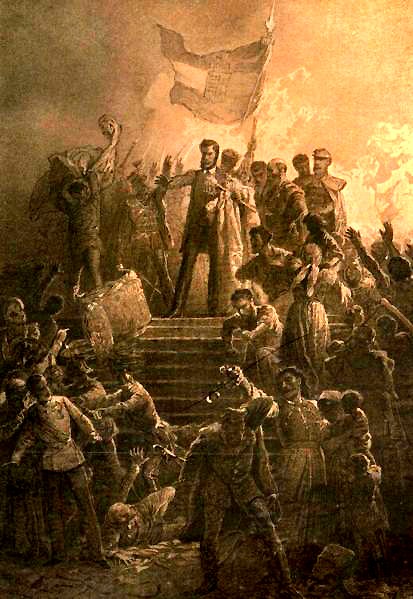
The Hungarian Revolution – Artist Mihály Zichy‘s painting of Sándor Petőfi reciting the new Hungarian national song to the crowds.
The Hungarian Revolution was crushed only because the Russian Czar, the only person more conservative than the Hapsburg emperor, sent tens of thousands of troops to destroy it. However the Hapsburg emperor had to accede to some of the Hungarian demands for independence,, and in 1867, reached the Great Compromise which saw the throne of Hungary elevated to the equal of Austria, and a rebranding of the Austrian empire to the “Austro-Hungarian empire”. Though the new Austro-Hungarian emperor Franz Jospeh sat on both thrones and dictated joint foreign policy,, the Hungarian Diet was given almost complete autonomy over domestic government.
The end of the line
Franz Joseph would be Hapsburg emperor from this tumultuous year of 1848 all the way to 1916. Franz witnessed new nations built from the bones of his ancestors’ empire. He lost entire territories of Austria to nationalism and his entire world to the rising tide of liberal Parliamentary democracy. He is remembered fondly in Vienna today, and walking tours extoll his spartan, hard-working, god fearing lifestyle, but if you were fighting for Italian or Hungarian independence, or generally were a person of rebellious disposition in the nineteenth century, Franz Joseph was The Bad Guy, the Arch Reactionary, the very embodiment of the Old World.
Franz Joseph’s personal life was as tumultuous as the times he lived in. It feels fair to end the story of a family which began with Radblot’s castle with the last days of the last great Hapsburg. Franz Joseph is eclipsed in his posterity by his wife the Empress Elizabeth, lovingly called “Sisi” in Vienna. I did not know about Sisi before I visited Vienna, but if you are on the tourist trail in Vienna, you would think Hapsburg history began and ended with her. She occupies a place in the national imagination analogous to Princess Diana in England. Part of this was the fact that she was one of great beauties of the nineteenth century, a reputation she was well aware of, employing a strict diet and exercise regimen which allowed her to keep her elven looks and famously thin figure well into her fifties. She was most famous for writing melancholy poetry about how stifling court life was, lamenting her marriage to Franz Joseph at fifteen, and, generally chafing against her gilded cage. The doomed princess is believed to have intervened in the cause of Hungary, and is said to have swayed Franz Jospeh to agree to the compromise of 1867, earning her the admiration of liberals as well..
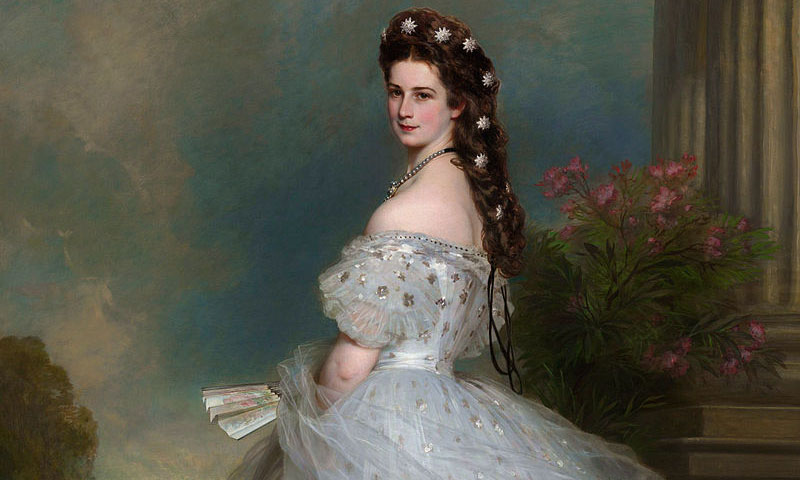
Her poetry had already garnered her fame, but, Sisi’s dramatic death has seemingly won her immortality.The Hapsburg government was already in crisis following the death of Sisi and Franz Joseph’s only son Rudolf, heir to the Austro Hungarian empire. The prince Rudolf – always a gloomy type – had, after years in an unhappy arranged marriage, ended up shooting himself along with his mistress, in a scandalous murder-suicide pact. This had prompted the already detached empress Sisi to withdraw completely from court life, and embark on a grand tour of Europe. Whilst she was promenading in Geneva, she was suddenly violently bumped into by a strange man in a long black coat. The man rushed off, disposing of a bloody knife in his wake. It was only minutes later, when a spot of blood began growing on her corset, that the Empress realised she had been fatally stabbed. She collapsed soon after, never to wake again.
The assassin was the Italian anarchist Luigi Lucheni. Lucheni did not offer any resistance when he was arrested by the police for the murder of the Hapsburg empress. When he was questioned about his motive he simply said ‘Because I am an anarchist, because I am poor, because I love the workers and I desire to see the death of the rich.’

Following the deaths of his wife and son, Franz Joseph declared that the heir to the throne would be his nephew Franz Ferdinand. Franz Ferdinand was the archetypal Hapsburg aristocrat straight out of the old world, famous for never smiling in public, spotted in theatres and operas with a cold haughty stare frozen on his face, acknowledging neither the audience or the performance. He had great plans for the revitalisation of Austria, all of which entailed using the army to crush what he saw as the four great problems plaguing his empire “Freemasons, Jews, Socialists and Hungarians.”
He would never have the chance, for it would next be Franz Ferdinand’s turn to be assassinated. This was of course by the Yugoslav nationalist Gavrilo Princip, in Sarajevo, 28 June 1914. At his trial, Princip defended his actions saying : “I am a Yugoslav nationalist, aiming for the unification of all Yugoslavs, and I do not care what form of state, but it must be freed from Austria.” Like many nationalists from the Balkans to Italy, he did not know what shape the new world would take, but it would have to be a world without Austria Hungary.
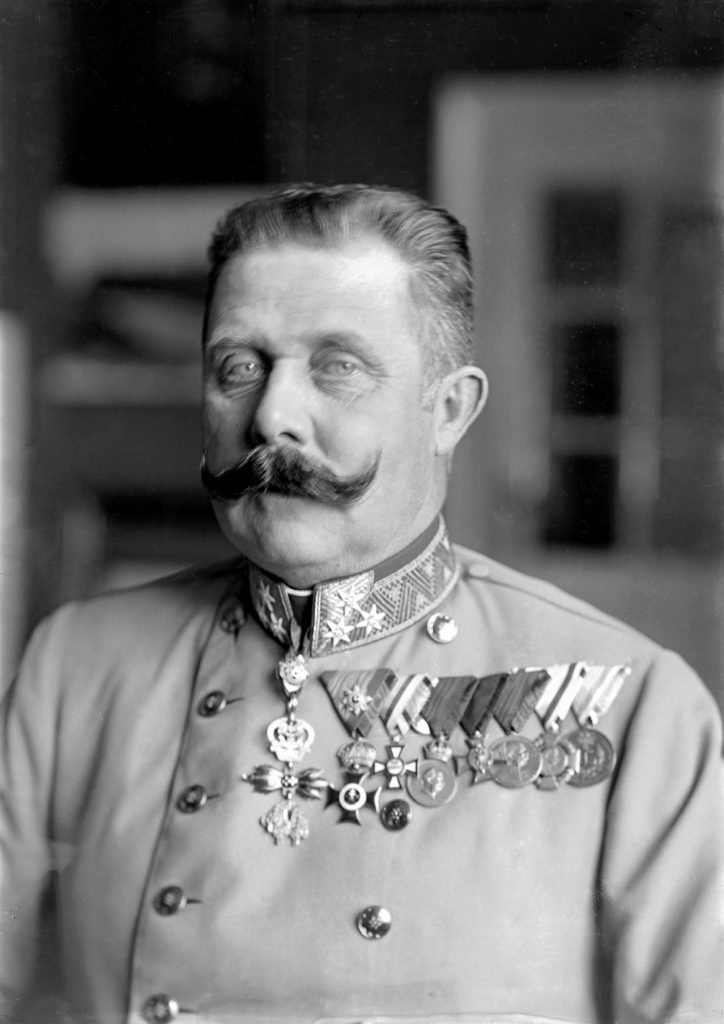
The two bullets fired by Princip into the chests of Franz Ferdinand and his wife famously set off a chain of events that resulted in the First World War, a spectacle of blood in which the modern world was born screaming. In a way, Princip achieved his aim, for it was also a conflict the Austro-Hungarians were destined not to survive. In 1918 the Hapsburg empire would be gone forever, and the family which had held Europe in the palm of its hand for six hundred and fifty years would vanish into the shadows.
